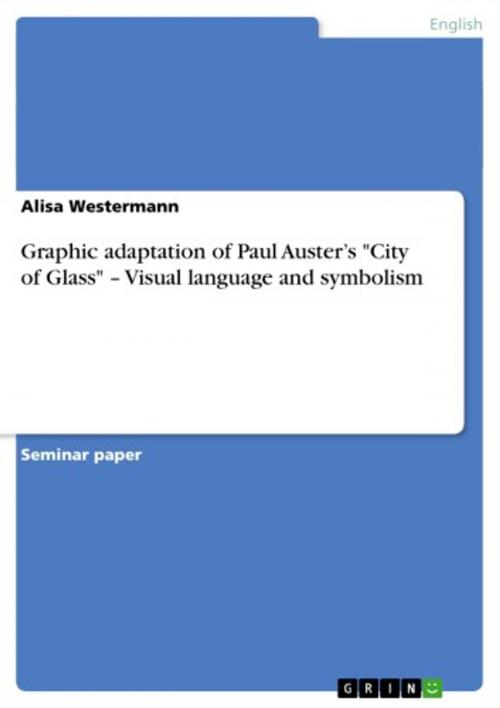Graphic adaptation of Paul Auster's 'City of Glass' - Visual language and symbolism
Fiction & Literature, Literary Theory & Criticism, British| Author: | Alisa Westermann | ISBN: | 9783640935307 |
| Publisher: | GRIN Publishing | Publication: | June 10, 2011 |
| Imprint: | GRIN Publishing | Language: | English |
| Author: | Alisa Westermann |
| ISBN: | 9783640935307 |
| Publisher: | GRIN Publishing |
| Publication: | June 10, 2011 |
| Imprint: | GRIN Publishing |
| Language: | English |
Seminar paper from the year 2009 in the subject English Language and Literature Studies - Literature, grade: 1,3, University of Münster (Englisches Seminar), course: Graphic Novels, language: English, abstract: It was a wrong number that started it, the telephone ringing three times in the dead of night, and the voice on the other end asking for someone he was not. (Auster, 1985; 3) Paul Auster's anti-detective novel City of Glass is the story of a man, whose life accidentally angles off. More and more, he blunders into the complexity of a criminal case in search of the significant principle. Obsessively, he adapts his action to the stranger until he finally loses hisself. Although Auster's novel, which is based on the nature and the function of language, is rather non-visual, Paul Karasik and David Mazzucchelli succeeded in adopting it into a graphic novel that is more than just a translation from one genre into another. They managed to create a visual language full of metaphors, symbols and icons that add a new layer of meaning to the story. This is the reason why I decided to pick City of Glass: The graphic novel as the basis of my term paper. This thesis will argue that a graphic adaptation of a literary work can be more than just an illustrated copy of a superior novel and worth an analysis on its own. Furthermore, I will take a deeper look at the visual language, specifically, the visual metaphors and symbols, which build up the graphic novel and how these finding can be adapted into learning situations. First of all, I will give a summary of City of Glass: the novel followed by a definition of the anti-detective genre with the intention to point out, that the visual language of City of Glass: the graphic novel reflects this genre. Afterwards, a survey of the graphic novel as well as an analysis of its structure and composition and its visual language and symbolism is given. A brief outline of how these findings can be useful in teaching and learning situations will precede the conclusion.
Seminar paper from the year 2009 in the subject English Language and Literature Studies - Literature, grade: 1,3, University of Münster (Englisches Seminar), course: Graphic Novels, language: English, abstract: It was a wrong number that started it, the telephone ringing three times in the dead of night, and the voice on the other end asking for someone he was not. (Auster, 1985; 3) Paul Auster's anti-detective novel City of Glass is the story of a man, whose life accidentally angles off. More and more, he blunders into the complexity of a criminal case in search of the significant principle. Obsessively, he adapts his action to the stranger until he finally loses hisself. Although Auster's novel, which is based on the nature and the function of language, is rather non-visual, Paul Karasik and David Mazzucchelli succeeded in adopting it into a graphic novel that is more than just a translation from one genre into another. They managed to create a visual language full of metaphors, symbols and icons that add a new layer of meaning to the story. This is the reason why I decided to pick City of Glass: The graphic novel as the basis of my term paper. This thesis will argue that a graphic adaptation of a literary work can be more than just an illustrated copy of a superior novel and worth an analysis on its own. Furthermore, I will take a deeper look at the visual language, specifically, the visual metaphors and symbols, which build up the graphic novel and how these finding can be adapted into learning situations. First of all, I will give a summary of City of Glass: the novel followed by a definition of the anti-detective genre with the intention to point out, that the visual language of City of Glass: the graphic novel reflects this genre. Afterwards, a survey of the graphic novel as well as an analysis of its structure and composition and its visual language and symbolism is given. A brief outline of how these findings can be useful in teaching and learning situations will precede the conclusion.















